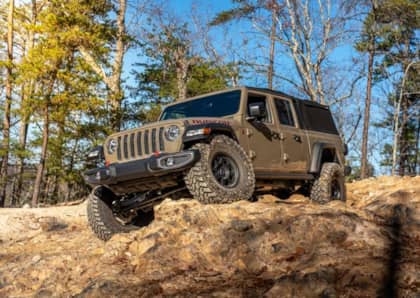All About Drag Radials

Your car ending up with the right sort of tires can mean the difference between you and traction becoming really good friends with one another, or you not being able to do all sorts of important things, like stop, turn or cut a better sixty-foot than a base-model Dodge Caravan.
If whatever it is you plan on drag racing spends any amount of time on the street, chances are you’ve considered a set of drag radials. That’s mostly because of how versatile they can be. It turns out that drag radials are the best compromise between you being able to lay down almost all of your power at the strip and you still being able to schlep yourself to work come Monday morning, all on the same set of rubber. Which is exactly what Nitto had in mind when developing drag radials like, say, the NT05R, a tire aimed directly at the modern muscle car market.
D.O.T. Compliance
Developing a tire that does one thing very well isn’t terribly hard. Take racing slicks, for instance, whose job it is to grab onto the pavement as effectively as possible. Here, things like wet-weather performance and the ability to make one-handed U-turns don’t matter a whole lot. Drag radials, on the other hand, have got two parties to answer to: the guy with the Charger who’s tired of lighting up his rear tires, and the D.O.T. (Department of Transportation) who says tires destined for public roads have got to have a few important features, like tread, and sidewalls that won’t collapse. Ask the D.O.T. and it’ll tell you that in order for a drag radial to be road-legal, it has to have a minimum tread depth of 1/16-inch. It’s also got to be hydroplane-resistant. But according to Nitto Tire engineer Andrew Frank, although drag radials meet every single one of those D.O.T. requirements, they do so by a smaller margin than, say, those tires your aunt just had installed onto her Buick.
Radian vs. Bias-Ply
Drag radials aren’t the only kind of D.O.T.-compliant competition tire, though. There are also bias-ply tires—sometimes called cheater slicks—which you ought to know about before determining whether or not drag radials are right for you. According to Frank, at the track, bias-ply tires win. But only marginally. “In heads-up racing with two identical vehicles, only difference [being] tire construction,” says Frank, “the bias-ply tire will probably [result in a] lower ET.” But the bias-ply tire’s got a problem, and it’s a big one: it’s just not able to handle things like bumps and corners as well as a drag radial can, which is exactly the sort of stuff you’re probably going to encounter driving to and from the track. In other words, a drag radial like the NT05R will give you roughly 90-percent of the traction you need and still get you home safely without the sort of things you’ve been avoiding, like dedicated wheels and tires for the track or a truck and trailer.

Nitto’s NT05R drag radials are aimed squarely at the modern muscle car market and are available in sizes ranging from 275/40-17 all the way up to 315/35-20.
Talking Tread
It’s a drag radial’s tread that, in part, determines just how streetable it’ll be—and by streetable we mean whether or not you’ll be able to do things like drive in the rain. The NT05R’s tread, for example, looks a whole lot like what you’ll find on Nitto’s ultra-high-performance summer tire, the NT05. The difference, however, are the NT05R’s larger tread blocks that have less space in between them and the softer compound they’re made up of that results in a treadwear rating of 00 as opposed to the NT05’s 200. Nitto isn’t able to share any specifics on the NT05R’s specialized compound, however, according to Frank, it’s exclusive to the NT05R and was designed to outperform even the company’s already impressive NT555R.
But you didn’t come here to read about a set of tires with a 200 treadwear rating that’ll last you 40,000 miles. You came here for the sort of things a drag radial’s made up of that’ll turn, say, your 12-second car into an 11-second car. It’s that big, old, fat patch of uninterrupted rubber spanning around the center of a drag radial that let’s all of this happen, improving grip mostly due to the absence of any sort of tread.
The story doesn’t end with larger tread blocks and smooth rubber strips, though. Like racing slicks, a drag radial’s able to comply with the weight of the car unloading on itself when launching yet remain stable enough for high-speed stability at the track’s top end. All of this is accomplished through specialized sidewall and cap construction that are all about compromise but without you ever really knowing it. Here, the NT05R’s sidewall is softer, allowing for lower tire pressure while at the track. Its shoulder blocks are also bigger, resulting in a larger contact patch.
That Nitto’s NT05 and NT05R share the same name and a similar tread pattern was no accident. According to Frank, all of this means that you can end up with matching tires all around, despite your rears (or fronts) being something just a little more special than what’s sitting at the other end. It’ll also give you exactly the sort of traction you need to beat something a whole lot more impressive than an ’80s minivan.

The NT05R features larger tread blocks with less space in between them when compared to the NT05 as well as a softer, stickier compound.

The NT05R also features a specialized sidewall that’s softer than the more conventional NT05, which means tire pressure can be reduced at the track for even better traction.

The NT05R’s shoulder blocks are bigger, too, resulting in a larger contact patch and better traction.
For more info on the Nitto NT05R, visit nittotire.com.
(Photos: Ignition MG)







